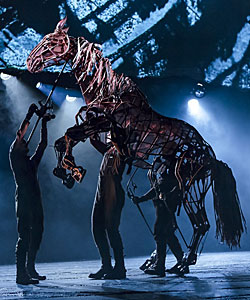
Yes, the horse is magnificent—bits of wood, fabric, and plastic ingeniously configured in a way that will leave you swearing by the gods of the Triple Crown that what you are watching is a flesh-blood steed and not an inanimate puppet incarnation thereof.
But even the world’s most extraordinary puppetry can’t, by itself, create a compelling story. For that, you need characters that are not underwritten and a narrative that’s not 175-proof schmaltz. Unfortunately, War Horse provides neither. There’s no denying the originality and amazing artistry of the horse Joey, Adrian Kohler and Basil Jones’s living sculpture of an equine. Would that Joey served a story that was more than the on-stage equivalent of a Very Special Hallmark Movie.
Let’s start with what works about War Horse, shall we? First and foremost there’s Joey, seen first as a spirited foal and later, in a moment of sheer on-stage magic, morphing into a full grown stallion. Crafted from plywood, plastic, and mesh, Joey is at once spectacle and spectacular. The three artists manipulating Joey are both virtually invisible and in plain sight as they put Joey through his paces. Galloping at the head of a cavalry charge, grazing in a meadow, hauling a plow across a rural Irish farm, Joey provides s a masterful example of illusion created by superior craftsmanship and the power of suggestion. Right down to the slightest flicker of a tail, he’s every inch a believable horse.
The secondary element of War Horse that is beautifully impressive is its music, composed by Adrian Sutton and directed by Greg Pliska. While not a traditional musical—there’s no jazz hands or dance ensembles—War Horse is infused with song. When Sutton’s lilting folk tunes and powerful ballads flow from the stage, War Horse is at its strongest and most evocative. The sounds are haunting, and have far more of an emotional impact than the actual narrative.
And that brings me to the story of War Horse, a tale peopled with stock characters (quick summary: boy meets horse, horse goes off to war, horse tries to reunite with boy). Nick Stafford’s adaptation of Morpurgo’s book is sentimental unto treacle, a maudlin tale carefully calculated to yank the heartstrings. And that it succeeds in doing, if the performance I saw was any indication. As the rest of the audience veered between tears of joy and tears of tragedy, I was left fervently wishing the human portions of War Horse had the depth and passion of its puppets.
War Horse continues through January 5 at the Cadillac Palace Theatre, 151 W. Randolph. For more information, go to broadwayinchicago.com.
Catey Sullivan is Chicago magazine’s contributing theatre critic.
Photograph: Broadway in Chicago



